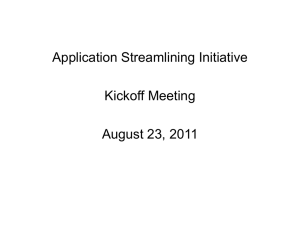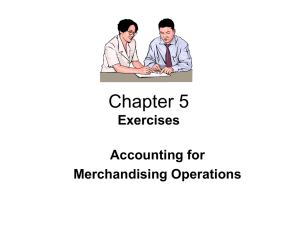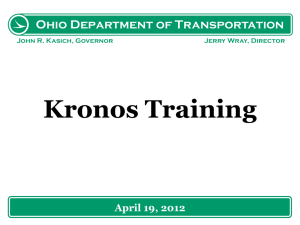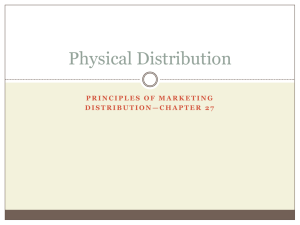0916 Merchandise Budget III Blackboard
advertisement
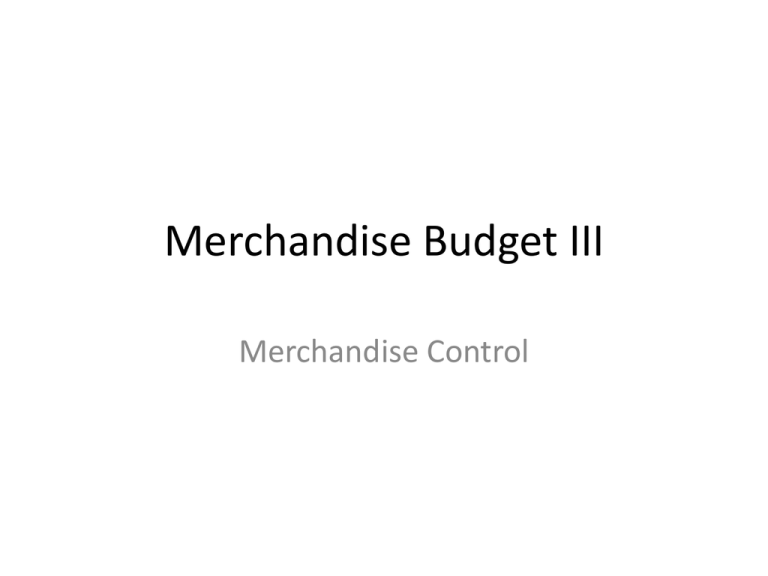
Merchandise Budget III Merchandise Control Estimating Monthly Reductions • Markdowns are part of merchandising, particularly in apparel or fashion lines—impossible to match all consumers’ needs with certainty with respect to sizes and styles. • Employee discounts are important in building “selling confidence” in merchandise. • Shortages, such as errors in recording sales, receiving goods, recording markdowns, employee theft, and shoplifting. Reductions • Historically, department store reductions (markdown, discounts) exceed specialty store reductions (NRMA statistics). • Initial markon, or initial markup percentage must cover reductions: (Gross margin $s + Markdowns $s) (Net sales $s + Markdowns $s) • Determine the dollar amount, and then allocate to various months, consistent with NRMA statistics. Retail Inventory Method • Retailers must maintain accurate records of inventory investments, such as a perpetual book inventory. • Practicality and conservative approach. • Pre-established initial mark-up and costcomplement (cost-multipliers), procedures. • As markdowns become a larger part of the business, RIM method become more attractive. Inventory Movements Tracked at Retail at Initial Markup Total Goods Handled Cost Beginning inventory Purchases - Returns Retail $ 40,000 144,000 240,000 (6,000) Net Purchases $ 70,000 (11,000) 138,000 229,000 Transfers in 2,000 3,200 - Transfers out (3,000) (4,800) Net Transfers (1,000) Freight in 3,000 Markups 1,400 - Markup cancellations (400) Net Markups Total Goods Handled (1,600) 1,000 $180,000 $300,000 Initial markon = $300,000 – 180,000 =$120,000 or 40% In-Season Adjustment to Inventory All Completed at Retail, or at the Sales Register Total Goods Handled Cost Gross Sales - Consumer Returns Retail $240,000 (10,000) & Allowances Net Sales $230,000 Markdowns 20,000 - Markdown Cancellation (2,000) Net Markdown Employee Discounts Total Reductions to Inventory 18,000 2,000 $250,000 Applying the Cost Multiplier, Cost Complement, Cost to Retail Ratio Cumulative Markon = (total retail - total cost) / total retail: ($300,000 - $180,000) / $300,000 = 40% The Cost Multiplier = total retail -cumulative markon (100% - cumulative markon%) =60% Ending book = total goods handled at retail - total inventory at retail reductions: $300,000 - $250,000 = $50,000 Ending book inventory at cost = ending book inventory at retail x cost multiplier: $50,000 x 60% = $30,000 Components of Retail Inventory • Markon, initial % markup • Reductions: Markdowns, discounts, and shortages. • Cost complement (cost multiplier) • Public Accounting Firm Audit Initial Markup & Cost Complement • A retailer with a maintained margin (gross margin) of 35%, has planned sales of $230,000 for a season, with total reductions (markdowns) of $20,000. • What is the retailer’s initial markup % ? • What is the cost complement, cost multiplier? Sample Test Question 1 • A department store has planned sales of $500,000, with $300,000 in gross margins for a season, and expects no markdowns. • What is the retailers initial markup % ? Sample Test Problem 2 • A retailer with a maintained margin (gross margin) of 25% has planned sales of $400,000 for a season, with total reductions (markdowns) of $50,000. • What is the retailer’s initial markup %? • What is the retailer’s cost complement? Sample Test Question 3 • A department store forecasts gross margins $70,000 on planned sales of $180,000 for a season, with total reductions (markdowns) of $20,000. • What is the retailers initial markup % ? Sample Test Question 4 • A retailer adds $120,000 markon to goods that cost the retailer $180,000. What is the initial markup %? • What is the retailer’s cost complement? • If markdowns of $60,000 are needed to sell all the goods, what are the net sales and the maintained markup %? Sample Test Question 5 • A department store with a maintained margin (gross margin) of 40% has planned sales of $500,000 for a season, with total reductions (markdowns) of $100,000. • What is the retailer’s initial markup % ? Decentralized Inventory • Retail Inventory should be in the stores—not in distribution centers • If inventory were in a single location, tracking inventory movement, or “costing out” each sale, might not be a problem, such as at an auto dealership. • Consider if you had highly trained specialists versus the reality of highly untrained generalists. Markdowns • Frequency of – Early markdowns – Markdown cancelations – Additional mark-ons for price increases – Vendor mark-down money for close out • Without markdowns, or highly frequent markdowns, the RIM is less important. • A source of negotiation between buyer and seller. “Self-Serving Reasons” for Markdowns • Markdowns provide motivations to move “obsolete” merchandise. • Markdowns are usually associated with advertisements, or announced events. • Markdown “money” provides a reason for negotiations between a buyer and seller. • Markdown money provides an incentive to new sellers (or suppliers). Stock-to-Sales Ratios • Ratio of inventory (at retail) to monthly planned sales. • The inverse of a one-month turnover ratio. • Historical ratios are maintained to keep store in-stock of merchandise—provided to buyers, or embedded in software. Basic Stock Method • “Basic Stock” is an inventory amount “added” to planned sales and reductions to create a BOM Inventory. The difference of two components: • Average stock: (Total sales +reductions)/turnover • Average monthly sales: (Total sales +reductions)/months Basic Stock Method • Calculations for a six month merchandise budget BOM stock Basic stock ( Planned Basic stock Average stock Average stock season sales 146,500 - Average sales reductions monthly sales reductions Total planned Target tur Ave. monthly monthly nover rate 24 , 416 6 Basic stock 78,000 - 24,416 53 ,564 or 54,600 ) sales 146 , 500 1.88 78 , 000 BOM stock Basic stock ( Planned Basic stock Average stock Average stock season - Average sales reductions monthly ) sales sales reductions Total planned Target tur 146 ,500 monthly nover rate 78 , 000 1.88 Ave. monthly sales 146,500 24 , 416 6 Basic stock 78,000 - 24,416 53 , 564 or 54,600 54,600 is added to each month’s projected sales + reductions to create BOM inventory Cautions: Stock-to-Sales Ratios • Retailer specific— • Reported as averages—a retailer does not mind sharing their ratios as it does not have divulge planned sales nor dollar amounts of inventory at retailer. • The multiplier effects will “exaggerate” any anticipated shifts in planned sales without readjustments for the season. • Historically tracked by retailer. Stock-to-Sales Ratios • Ratio of inventory (at retail) to monthly planned sales. • The inverse of a one-month turnover ratio. • Historical ratios are maintained to keep store in-stock of merchandise—provided to employees, or embedded in software. • Once widely reported measure of inventory levels (National Retail Federation surveys) for “benchmarking.” Merchandise Control • Process of collecting and evaluating data on all aspects of each retail merchandise category, including sales, costs, shrinkage, profits, and turnover. Control is achieved through the maintenance of an inventory book where all data are evaluated. • The determination and direction of merchandising activities, both in terms of dollars (dollar control) and in terms of units (unit merchandise control). • Control begins with a plan, and for the merchandise category this begins with the merchandise budget. Merchandise Budget • Provide the plan for determining store inventories—what inventories should be. • Purchases and shipments of goods to stores are required to follow this plan. • Reductions to inventory, sales, returns, markdowns, and discounts are tracked with regard to the plan. • Shortages are deviations from the plan, the shipments in, and all recorded reductions. Cost Complement • Used to convert EOM Inventory from Merchandise Budget (@retail) to cost • Initial markup=45%, • Cost complement=55% Turnover: Retail versus Cost • A retailer’s 6 month budget has planned sales for season of $200,000, a maintained margin of 30%, an average EOM inventory of 80,000 and an initial markup of 45%. • By estimating markdowns, what is the turnover for period? • Using cost of goods sold, what is the turnover for the period? • Initial markup = (Gross margin + markdowns) (Planned sales + markdowns) • Cost complement = 1 – Initial markup • Cost of goods = 1 - Maintained markup (gross margin) • Turnover = Planned/Inventory@retail • Turnover = Cost of goods/Inventory@cost Estimate markdowns and determining turnover Initial markon 45 % .45 60,000 x 200,000 (.45 200,000) x Gross margin markdowns Sales markdowns ; .45 x 60,000 x 30,000 .55 x ; 54 , 545 markdowns Turnover 200 , 000 54,545 80 , 000 254 , 545 80,000 3 . 18 Turnover is identical to cost method Turnover Cost of goods sold Inventory @cost Cost of goods sold Net sales - gross margin Inventory @cost Inventory 200,000 - 60,000 80 , 000 * . 55 @retail 140,000 44,000 * Cost complement 3 . 18 Seasonality: Why We Need a Buying Process • If demand were predictable • If demand didn’t change with style and fashion trends • If there was no complications due to reductions • If there weren’t differences among suppliers to changing styles or demand • If there was no differences among competitors Intertype Competition • Single-line, “limited line,” specialty retailers “Kiosk” based specialists • Category specialist, category killer • Family clothing stores • Department store • Discount department stores • Warehouse club or supercenter • Local seasonality combined with seasonality of the merchandise line tends to favor… Assumptions • Change in the seasonal characteristics of consumer demand for a merchandise line is negligible, or “geological” • Intertype competition shifts in demand are “revolutionary” in comparison • Management of the merchandise budget may vary slightly from retailer-to-retailer, however, the nature of supply provides standardization. Seasonal Characteristics • Predictable, recurrent seasons – “Back to school,” school supplies – Christmas Holiday, outdoor decorations – Lawn mowers, lawn fertilizer, bedding plants • Less predictable – Men’s swimwear, shorts – Sweaters, sweater vests – Children’s “dressy” clothes Intertype Competition • “Generalists” – – – – – Discount Department Stores Supercenters & Warehouse Club Conventional Department Stores “Dollar” Stores, “Big Lots” Home Centers (Lowe’s, Home Depot) • “Specialists” or Limited Line Retailers – – – – Men’s, Women’s, & Family Clothing Stores Limited-line sporting goods Home electronics Toy, hobbies, and games We typically, we assign certain product to classifications: • Men’s underwear versus women’s underwear? • Men’s dress shirts, collars, sizes—”expectancy” of standards of fit, neck size. • Men’s shoes versus women’s shoes What are the implications of seasonal merchandise and seasonal geography on retailing structure and competition? • What conditions would be hardest for a yearround specialty retailer (limited assortment)? • What combinations of seasonality favor a general merchandise, wide assortment retailer? Inventory Control • The validity of all of the prior discussion is contingent on merchandise that was ordered actually making it into retail display space and remaining there until the sale is recorded at cash register. • Opportunities for fraud and theft are abundant on and off the sales floor. • How can the buyer be assured that the planned purchases arrive, and are displayed, on the selling floor? Monitoring “Issues” • Monitoring is important when employees are in charge of operations and separated from ownership. • When the owner of the store is also the manager, the buyer, and inventory control manager—there is no need to monitor. • When the manager of the store is also the buyer and responsible for inventory control… Avoid the following practices as a buyer: • Spending time with vendors outside of the buying offices. • Spending too much time “receiving” goods at the stores. • Fraternizing with individuals within your own firm’s accounting division. Retailer Accounts Payable Purchasing Receiving Purchase Order Financial Intermediary Sales Carrier Shipping Invoice Accounts Receivable Supplier Bill of Lading Three areas of concern • Planned purchases from merchandise budget become purchase orders—do purchase orders follow the plan—or exceed plan? • Purchases orders become invoices—do the quantities and prices match the purchase orders? Is vendor allowed to substitute? • Receiving: Do the goods received match the goods invoiced? Are they in saleable condition? Who determines if merchandise is returned? Merchandise Budgets are Plan for Control • Do purchases orders correspond to budget plans? • Can all accounts payable be assigned to specific budget plans and from vendors in the plan? • Do actual goods in stock in stores correspond to planned BOM inventories and sales.


